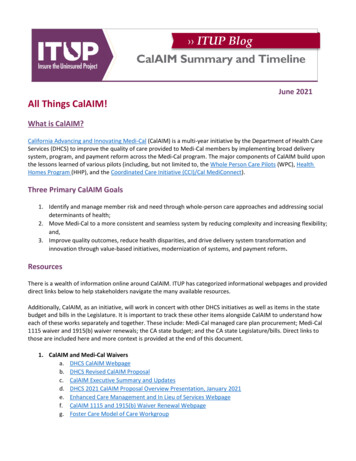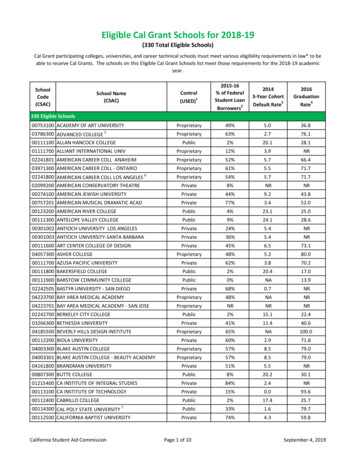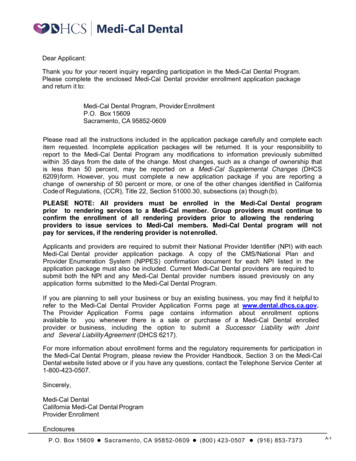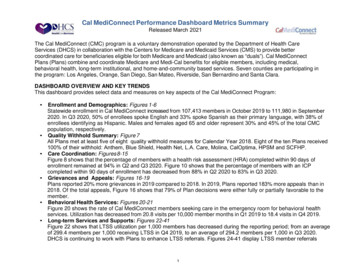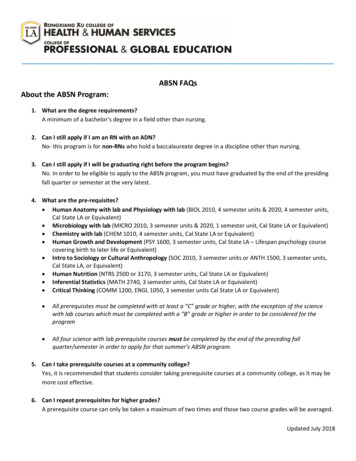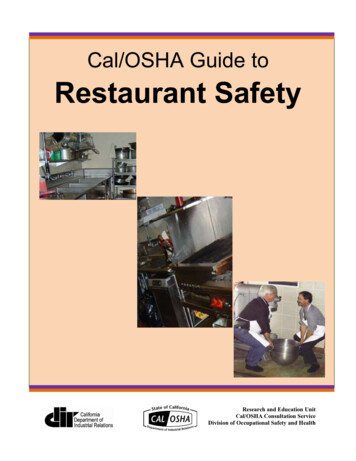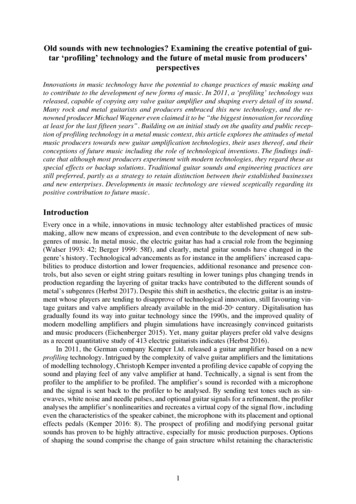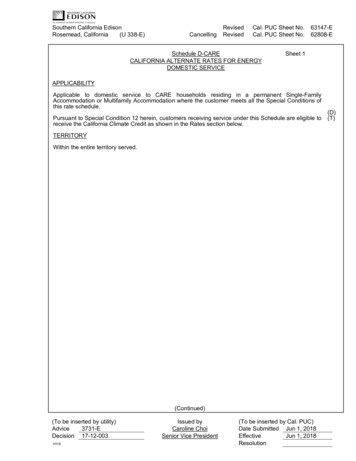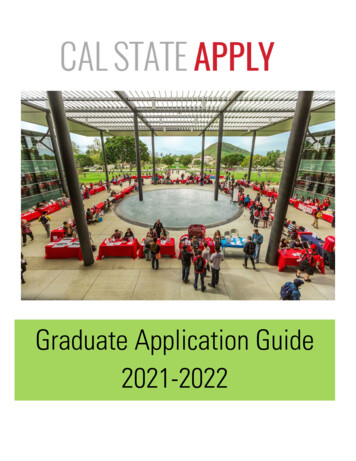Transcription
The SCAN Foundation’s AnnualLong-Term Services and Supports SummitCal MediConnect at Three YearsSARAH BROOKSDEPUTY DIRECTOR, HEALTH CARE DELIVERY SYSTEMSCALIFORNIA DEPARTMENT OF HEALTH CARE SERVICESOC TOBE R 2 6 , 2 0 1 71
The Road to Coordinated Care2
Strengthening & Improving Cal MediConnect In order for Cal MediConnect to be successful over the long term, we know weneed to continue strengthening the quality of care beneficiaries receive, and ensuresustainable participation in the program. Lots of helpful evaluation data has come out that helped us drive theseimprovements, particularly: Developing clearer beneficiary education materials;Encouraging care coordination activities;Expanding use of long-term services and supports; andImproving continuity of care.3
Outreach & Education4
Educating BeneficiariesWe are most successful when beneficiaries are engaged in theircare.Evaluation efforts flagged the continued need to ensure thatmaterials clearly explain beneficiaries’ health care options.DHCS has developed new education and enrollment materialsthrough a rigorous stakeholder and user testing process.5
New Cal MediConnect & MLTSS Guidebook6
New Beneficiary Toolkit7
Improve CalDuals.orgThis revamped website has a more user-friendlydesign and navigation, particularly catering tobeneficiaries.Thank you to the California Collaborative for LongTerm Services and Supports and to the CalDualswebsite workgroup members for their help on thisproject.8
Targeted Provider OutreachDHCS has been conducting intensive provider education based on ourdetailed analysis of beneficiaries who have opted out of CalMediConnect.This data allows us to identify providers (including physicians, hospitals,and medical groups) associated with large numbers of beneficiaries whohave chosen not to participate in Cal MediConnect. DHCS intends touse these data to more effectively target provider education andoutreach activities in partnership with the health plans and otherpartners.We know that providers are an important source of information forbeneficiaries. We want to be sure providers and beneficiaries havegood information, and we want to address misconceptions.9
In-Network Communication Providers new to managed care need extra support – particularly nursingfacilities in California. DHCS has hosted provider summits in Los Angeles and the Inland Empire tosupport broader communication. Sessions have focused on care coordinationtopics, continuity of care, as well as billing and delegation. The sessions havebeen at capacity – showing there is a hunger for information. We’ve developed pilot programs to teach hospital case managers how toleverage Cal MediConnect plans to support member transitions in coordinationwith both the plans and the California Hospital Association. Dementia Cal MediConnect is leveraging expertise of Alzheimer’s Greater LosAngeles to train plan care managers.10
Provider Engagement StrategiesTailored materials for providers, with actionable information (e.g.,how to bill Cal MediConnect plans).In particular, it’s helpful to educate providers about how CalMediConnect can help support their practice – reduce theadministrative burdens on staff who often help beneficiariesstruggling with social needs. A Cal MediConnect Hospital Case Manager Toolkit is one tool we havedeveloped to help in care transitions back into the community. Monthly Webinars compliment the in-person outreach.11
Example: Improper BillingWe conducted extensive outreach and education effortsaround an issue impacting duals - improper billing,sometimes called “balance billing”. Provider bulletin Provider webinars Fact sheets for beneficiaries MCP best practices meeting Advocate training12
Overall Outreach NumbersOver 2016, the state outreach team worked to ensure beneficiaries, providers,and other stakeholders have clear, accurate, and actionable CCI-information.Across CCI counties, the team conducted town halls, resource fairs, health fairs,presentations, webinars, and other outreach events.This work amounted to educating over 10,000 beneficiaries, providers, andother stakeholders through more than 50 outreach events per month, over 80monthly webinars, and the distribution of thousands of educational materials.13
Enrollment StrategiesIn response to stakeholder feedback, DHCS is pursuingenrollment strategies that support voluntary “opt-in”enrollment. Building on the work already underway byDHCS and the Cal MediConnect plans, DHCS has taken anumber of actions, including Streamlined Enrollment Mandatory MLTSS Enrollment14
Program Improvements15
Encouraging Care Coordination Evaluation efforts show that care coordination is working forbeneficiaries who are receiving those services and that it increasesbeneficiary satisfaction with the program. DHCS is working with the plans to help expand utilization of the CalMediConnect care coordination services: Data reporting on care teams and care plans with improveoversight and accountability; Best practices meetings will help plans learn from each other; Provider toolkits and trainings to encourage greater collaborationin care delivery.16
Increase Access to LTSS Improving access and coordination with LTSS services is a key part of CalMediConnect, and the evaluation efforts show this is an area where wecan continue to work with the plans. DHCS, in partnership with CMS, will work to strengthen oversight of healthplan LTSS referrals. DHCS is implementing improved data reporting on LTSS referrals (seeprevious slide) DHCS convened a workgroup to develop standardized Health RiskAssessment LTSS referral questions that will go into effect January 2018. We will continue to watch and support coordination with IHSS services.17
Sharing Best Practices & Lessons Learned In May 2016, Cal MediConnect health plans began a series of meetingsto share best practices. Topics are selected in part based on evaluation data results that highlightareas where work can be done to improve the program for beneficiaries. DHCS believes these forums will improve collaboration and understandingamong different Cal MediConnect health plans and help ensure that allhealth plans are delivering high-quality, coordinated care to beneficiaries.18
Improving Continuity of Care Evaluation efforts clearly show beneficiaries want to have continuityof care with their physicians when entering a new health plan. Effective in October 2016, DHCS has improved the continuity of carepolicy by: Extending the continuity of care period for Medicare services from sixmonths to 12 months to match the Medi-Cal continuity of care period, and Modifying requirements to just one visit with a specialist within the past 12months, as is the case with primary care physicians.19
Future of Cal MediConnect20
Budget Implications Although all the pieces of the CCI were not found to be cost-effective, theprogram has shown the potential to improve the care and quality for thoseenrolled and help to keep individuals in their homes and community, therebyleading to likely long term cost reductions. Based on the lessons learned from CCI, the Budget extends the CalMediConnect program, continues mandatory enrollment of dual-eligibles, andthe integration of long-term services and supports (except IHSS) into managedcare. DHCS has requested from CMS that these three components of CCI be extendedfor an additional two years as part of the Cal MediConnect program.21
Resources and Contact Information For more information on the CCI – including enrollment, qualitydata, and toolkits – visit www.calduals.org. You can send any questions or comments to info@CalDuals.org.
Improve CalDuals.org This revamped website has a more user-friendly design and navigation, particularly catering to beneficiaries. Thank you to the California Collaborative for Long Term Services and Supports and to the
